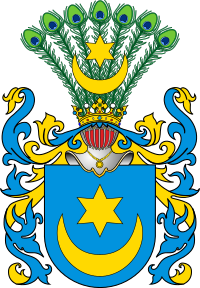Spytko II of Melsztyn
Spytek of Melsztyn | |
|---|---|
| Duke of Podolia [1] | |
 Spytek of Melsztyn in: Genealogical tree families: Tarnowski, Melsztyński and Jarosławski by Augustinus Thille, Wojciech Kazimierz Jastrzębski; reprint Adam Piliński. | |
| Coat of arms |  |
| Hereditary feudal duchy [4][5][6] | 13 June 1395 – 12 August 1399 [2][3] |
| Predecessor | Fyodor Koriatovych |
| Successor | Skirgaila |
| Born | c. 1364 |
| Died | 12 August 1399 Battle of the Vorskla River |
| Noble family | Tarnowski |
| Consort | Elizabeth Lackfi |
| Father | Jan of Melsztyn |
| Mother | Zofia of Książ |
Spytek of Melsztyn (Polish: Spytek z Melsztyna or Spytko Melsztyński) was a Polish nobleman (szlachcic) of the Leliwa coat of arms.
Spytek was owner of Melsztyn estates. He served as Court Marshal since 1373, voivode of Kraków Voivodeship since 1381, starosta of Biecz since 1383 and Kraków since 1390.
Continuing the idea of Władysław I Łokietek he initiated the marriage of Queen Jadwiga of Poland and Grand Duke of Lithuania – to become king of Poland – Władysław II Jagiełło.[7] In 1391–1396 Spytek reclaimed the Land of Wieluń[8] and Orzeszków from Prince Władysław Opolczyk. On 13 June 1395 the King gave Spytek a part of Podolia as fief, Queen Jadwiga confirmed this on 10 July 1395.[9] During the brief period when he was Duke of Podolia, he succeeded lead to the resignation Fyodor Koriatovych of the rights to Podolia and with Queen and King negotiated with Sigismund of Luxembourg (then King of Hungary) the border issue; and with the Bishop of Vilnius tried to prevent the secession of Lithuania from Polish–Lithuanian union, after acclamation by Vytautas the King of Lithuania on 12 October 1398. As Duke of Podolia also took part in the expedition against the Golden Horde, which ended the Battle of the Vorskla River.[10][11]
He was married to Elizabeth Lackfi and had four children: Jadwiga of Melsztyn, Dorota of Melsztyn, Katarzyna of Melsztyn and Spytek of Melsztyn and Jan of Melsztyn († 1429).[12][13]
Spytek died in fight with Tatars in the Battle of the Vorskla River in 1399. In the battle he had to show courage when the Lithuanian army, under the command of Vytautas, escaped.[14]
References
[edit]- ^ "Wielka encyklopedia PWN", Wydawnictwo Naukowe PWN, Warsaw, 2004, vol. 25 (Sg-Starmach), p. 474.
- ^ "Wielka encyklopedia PWN", Wydawnictwo Naukowe PWN, Warsaw, 2004, vol. 25 (Sg-Starmach), str. 474.
- ^ "Polski Słownik Biograficzny", publisher: Polska Akademia Nauk, Instytut Historii, printing house: Zakład Narodowy im Ossolińskich, vol. XX (Maria Józefa-Mieroszewski Krzysztof), Wrocław-Warszawa-Kraków-Gdańsk, 1975, pp. 412–415 (biographical note), p. 414 (about the reign of Podolia)
- ^ "Wielka encyklopedia PWN", Wydawnictwo Naukowe PWN, Warsaw, 2004, vol. 25 (Sg-Starmach), p. 474.
- ^ "Wielka encyklopedia PWN", Wydawnictwo Naukowe PWN, Warsaw, 2004, vol. 25 (Sg-Starmach), str. 474.
- ^ "Polski Słownik Biograficzny", publisher: Polska Akademia Nauk, Instytut Historii, printing house: Zakład Narodowy im Ossolińskich, vol. XX (Maria Józefa-Mieroszewski Krzysztof), Wrocław-Warszawa-Kraków-Gdańsk, 1975, pp. 412–415 (biographical note), p. 414 (about the reign of Podolia)
- ^ "Polski Słownik Biograficzny", publisher: Polska Akademia Nauk, Instytut Historii, printing house: Zakład Narodowy im Ossolińskich, vol. XX (Maria Józefa-Mieroszewski Krzysztof), Wrocław-Warszawa-Kraków-Gdańsk, 1975, pp. 412–415 (biographical note), p. 413.
- ^ During the war he commanded getting a series of cities, among others: Olsztyn, Krzepice, he commanded attack on Land of Opole, getting cities Gorzów Śląski, Olesno, Lubliniec. Forced to capitulate [the germanized] nephews of Vladislaus II of Opole. Also took part in the attack on Strzelce Opolskie, and also participated in the negotiations; – "Polski Słownik Biograficzny", publisher: Polska Akademia Nauk, Instytut Historii, printing house: Zakład Narodowy im Ossolińskich, vol. XX (Maria Józefa-Mieroszewski Krzysztof), Wrocław-Warszawa-Kraków-Gdańsk, 1975, pp. 412–415 (biographical note), p. 413-414.
- ^ Until the death of Hedwig in 1399 she was the King of Poland, and Jagiello was Prince consort with the right to use the title of the King. Even though he to a large extent ruled in the name of Hedwig.
- ^ "Polski Słownik Biograficzny", publisher: Polska Akademia Nauk, Instytut Historii, printing house: Zakład Narodowy im Ossolińskich, vol. XX (Maria Józefa-Mieroszewski Krzysztof), Wrocław-Warszawa-Kraków-Gdańsk, 1975, pp. 412–415 (biographical note), p. 414.
- ^ He infrequently used the title Duke of Podolia, because he was also a royal official, and such combining positions, was badly perceived. He usually signed letters: The Lord and successor Duchy of Podolia and Land of Samobor; voivode, and starost of Krakow. In Polish: "Pan i dziedzic ksiestwa podolskiego i ziemi samoborskiej, wojewoda i starosta krakowski", – "Polski Słownik Biograficzny", publisher: Polska Akademia Nauk, Instytut Historii, printing house: Zakład Narodowy im Ossolińskich, vol. XX (Maria Józefa-Mieroszewski Krzysztof), Wrocław-Warszawa-Kraków-Gdańsk, 1975, pp. 412–415 (biographical note), p. 414.
- ^ "Wielka encyklopedia PWN", Wydawnictwo Naukowe PWN, Warsaw, 2004, vol. 25 (Sg-Starmach), str. 474.
- ^ "Polski Słownik Biograficzny", publisher: Polska Akademia Nauk, Instytut Historii, printing house: Zakład Narodowy im Ossolińskich, vol. XX (Maria Józefa-Mieroszewski Krzysztof), Wrocław-Warszawa-Kraków-Gdańsk, 1975, pp. 412–415 (biographical note), p. 414-415.
- ^ "Polski Słownik Biograficzny", publisher: Polska Akademia Nauk, Instytut Historii, printing house: Zakład Narodowy im Ossolińskich, vol. XX (Maria Józefa-Mieroszewski Krzysztof), Wrocław-Warszawa-Kraków-Gdańsk, 1975, pp. 412–415 (biographical note), p. 414.
